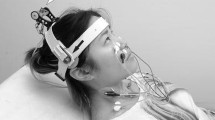Summary
Eye movements were recorded using DC-electro-oculography in 20 healthy subjects during sinusoidal voluntary head movements and during similar voluntary head movements with minimized cervical input. The eye movements during these conditions were compared to the vestibulo-ocular reflex (VOR), to the cervico-ocular reaction (COR) and to the active COR (i.e., voluntary stabilization of the head in space while the trunk was moved sinusoidally). Each subject sat with eyes covered on a rotating chair. Sinusoidal movements having an amplitude of ±20° and either 0.1 or 0.2 Hz were performed. Voluntary head movements and head movements with minimized cervical input showed no difference in the gain of the slow-phase velocity of the nystagmus, the saccadic activity (cumulated amplitude/time) and the maximum eye deviation. The distribution of saccades around the reversal of head movement in space represents the only significant difference between these conditions. While the saccades appear promptly after reversal during sinusoidal voluntary head movement, they appear during voluntary head movement with minimized cervical input just before the reversal of head movement in space. The direction of saccades always depends on the displacement of the head related to the trunk and is due to cervical input and/or central influences.
Similar content being viewed by others
References
Barlow D, Freedman W (1980) Cervico-ocular reflex in the normal adult. Acta Otolaryngol (Stockh) 89:487–496
Barnes GR (1979) Vestibulo-ocular function during coordinated head and eye movements to acquire visual targets. J Physiol (Lond) 287:127–147
Barnes GR, Forbat LN (1979) Cervical and vestibular afferent control of oculomotor response in man. Acta Otolaryngol (Stockh) 88:79–87
Biemond A, De Jong JMBV (1969) On cervical nystagmus and related disorders. Brain 92:437–458
Doerr M, Thoden U (1988) Zervikal ausgelöste Augenbewegungen. In: Wolff HD (ed) Die Sonderstellung des Kopfgelenkbereiches. Springer, Berlin Heidelberg New York, pp 83–91
Doerr M, Leopold HC, Thoden U (1981) Vestibulo-ocular reflex (VOR), cervico-ocular reflex (COR) and its interaction in active head movements. Arch Psychiatr Nervenkr 230:117–127
Doerr M, Hong SH, Thoden U (1984) Eye movements during active head turning with different vestibular and cervical input. Acta Otolaryngol (Stockh) 98:14–20
Doerr M, Schmitt HJ, Thoden U (1987) Die zerviko-okuläre Reaktion bei Trapezreizen. Z EEG EMG 18 R 151
Frenzel H (1928) Rucknystagmus als Halsreflex und Schlagfeldverlagerung des labyrinthären Drehnystagmus durch Halsreflexe. Z Hals-Nasen-Ohrenheilkd 21:177–187
Hülse M, Partsch CJ (1976) Cervical-Nystagmus ausgelöst durch Halsrezeptoren. HNO 24:268–271
Jürgens R, Mergner T, Schmid-Burgk W (1982) Modification of VOR slow and quick components by neck stimulation and turning sensation. In: Roucoux R, Crommelinck M (eds) Physiological and pathological aspects of eye movements. Dr. W. Junk, The Hague, pp 365–370
Köster W (1984) Untersuchung über den Einfluß tonischer Halsreflexe auf den horizontalen optokinetischen Nystagmus. Dissertation, University of Freiburg
Leopold HC, Doerr M, Thoden U (1983) Cervico-ocular responses (COR) during slow sinusoidal head movements in subjects with bilateral labyrinthine lesions. Arch Psychiatr Nervenkr 233:439–447
Leopold HC, Mertinat M, Thoden U (1985) Modulation of vestibulo-ocular reflex (VOR) by active stabilization of head to trunk. Acta Otolaryngol (Stockh) 99:102–106
Moser M (1974) Zervikalnystagmus und seine diagnostische Bedeutung. HNO 22:350–355
Sachs L (1978) Angewandte Statistik. Springer, Berlin Heidelberg New York
Takemori S, Suzuki JI (1971) Eye deviations from neck torsion in humans. Ann Otol 80:439–444
Thoden U, Doerr M, Leopold HC (1983) Motion perception of head or trunk modulates cervico-ocular reflex (COR). Acta Otolaryngol (Stockh) 96:9–14
Thoden U, Diefenhardt A, Kasper J, Mackert A (1987) Influence of vigilance in vestibulo-ocular reflex (VOR). EEG Clin Neurophysiol 66:80P
Author information
Authors and Affiliations
Rights and permissions
About this article
Cite this article
Doerr, M., Thoden, U. Eye movements during voluntary head motion with minimized cervical input. Arch Otorhinolaryngol 246, 20–25 (1989). https://doi.org/10.1007/BF00454129
Received:
Accepted:
Issue Date:
DOI: https://doi.org/10.1007/BF00454129




